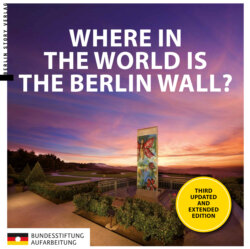Читать книгу Where in the World is the Berlin Wall? - Группа авторов - Страница 33
На сайте Литреса книга снята с продажи.
CASTEAU AT MONS BELGIUM Location: SHAPE, Military Headquarters of NATO
ОглавлениеThe Wall at NATO Headquarters, Casteau
© Photo courtesy of NATO
One of NATO’s two military headquarters in Europe (Supreme Headquarters Allied Powers in Europe, SHAPE) is located near the small Belgian town of Mons, near the village of Casteau. This is secondary to NATO’s political headquarters in Brussels. Supreme Headquarters Allied Powers in Europe (SHAPE) is situated in Casteau, north of the small Belgian city of Bons. A building, which was once of special significance during the Cold War, stands on this expansive military site. A special unit made up of western Allies was housed in the so-called “Live Oak building”. It would have been the unit’s job to to defend and support the western sectors if the Soviets cordoned off the West again – as they had done during the Berlin Blockade in 1948–1949.
The unit was established in 1959 by France, Great Britain and the USA. Under the codename “Live Oak”, it surveyed access to and from West Berlin.
Originally located near Paris, the unit was transferred to Belgium when France withdrew from NATO in 1967. After the building of the Wall in 1961, a delegate from the Federal Republic was also stationed at the unit and it was this person’s job to make contact with the federal government in the event of a crisis.
Information board on the Wall section at NATO Headquarters, Casteau
© Photo courtesy of NATO
Exactly what went on in the “Live Oak Building” was kept top secret during the Cold War. It was not until 1993 that information was made public. Just three years earlier, on the evening of 2nd–3rd October, the unit had denied its activities and purpose.
After the Fall of the Wall and the end of the Cold War, the ICC (Implementation Forces Coordination Cell) moved into the building. Amongst other duties, the ICC oversaw the placing of troops and the implementation of peace plans in Bosnia. By this time, the Russian military was also part of the ICC. A conference centre was later constructed for consultations by the states involved in the “Partnership for Peace”.
In the centre of four flag poles, an original piece of the Berlin Wall stands outside the entrance of the “Live Oak Building”. General Johan Galvin Saceur, the last “Live Oak” commander accepted the gift from Germany on 27th November 1990. It is flanked by two evergreen live oaks – a reference to the building’s name. The following text is inscribed on a plaque at the foot of the segment:
This section of the Berlin Wall symbolizes the division of Germany that existed after WWII until German Unification on 3. October 1990. The Live Oak Organization was dedicated to freedom of access to Berlin from 1959 to 1990.
France, United Kingdom, Federal Republic of Germany, United States of America
